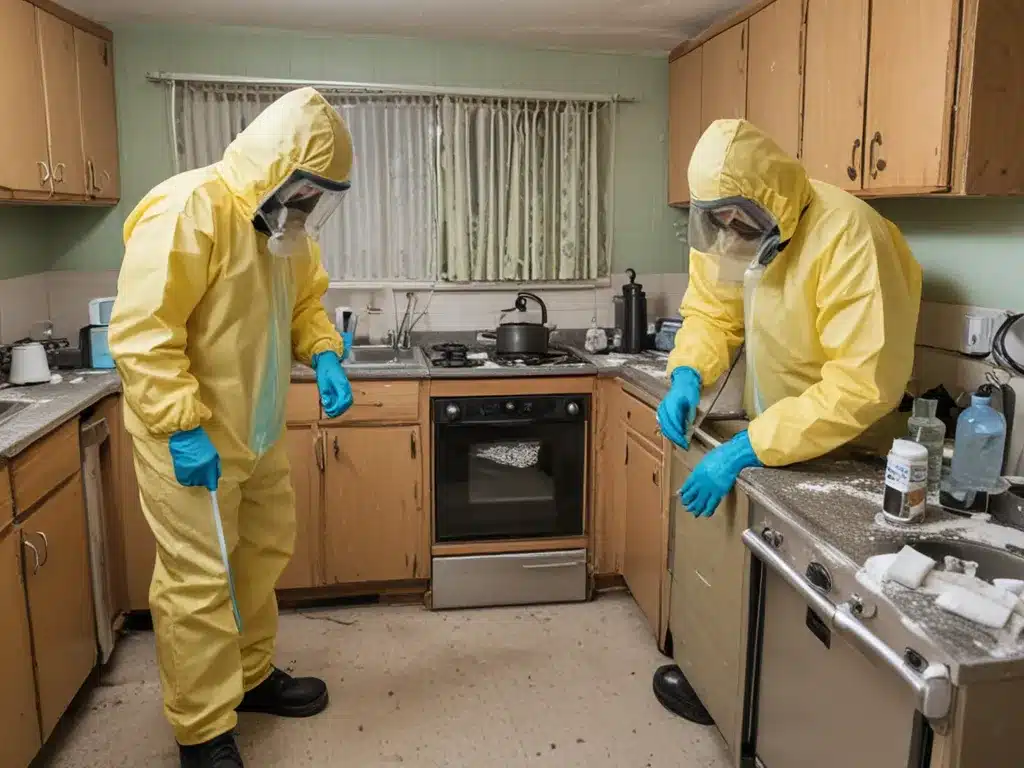Introduction
The manufacture of methamphetamine, commonly known as meth, in clandestine laboratories poses serious health and environmental hazards. Even after the lab is shut down, dangerous chemicals and toxic residues remain behind, putting occupants and future inhabitants at risk. As meth lab seizures continue to rise, the dangers of exposure and the proper remediation procedures have become increasingly important. This article provides an in-depth look at the detection and cleanup of former meth labs.
How Meth Labs Are Detected
Suspicion of meth manufacturing usually arises from tips or complaints of unusual chemical odors, excessive trash, frequent late-night visitors, or hazardous material dumping. Law enforcement will investigate and gather evidence to obtain a search warrant. Telltale signs of an active meth lab include:
- Strong ammonia, ether, acid or solvent odors
- Excessive security and surveillance equipment
- Strange burn marks or stained sinks/bathtubs
- High volume of cold medicine packages
- Numerous propane tanks and Coleman fuel cans
If enough evidence is found, a hazmat team suited in protective gear will raid the site and collect samples for field testing. The property can be quarantined if tests confirm meth manufacturing.
Dangers of Exposure
Exposure to meth labs presents serious health risks that must be addressed in remediation.
Chemical Hazards
Harmful vapors, gases, and residues permeate the structure from the volatile chemicals used to manufacture meth. These include:
- Solvents like acetone, methanol, and toluene
- Acids like sulfuric, muriatic, and hydrochloric acid
- Metals like mercury, lead, and lithium
- Corrosives like sodium hydroxide and ammonia
Fires and Explosions
The red phosphorus method of meth production carries a high risk of explosion and fire. Severe burns or lung damage can occur.
Meth Residue Contamination
Toxic meth particulates settle and accumulate on all surfaces. This “meth dust” can be inhaled, ingested, or absorbed through the skin. Long-term exposure may cause cancer or organ damage.
Assessment and Testing
A qualified industrial hygienist must thoroughly assess the site and test for contamination before allowing people to inhabit the structure again.
Initial Site Assessment
An initial site assessment visually surveys the property and interviews witnesses to determine:
- Meth manufacturing method – Red P, Nazi, or shake and bake
- Chemicals found – Precursor ingredients and waste
- Cooking areas – Exposure levels in each room
- Safety concerns – Structural soundness and stability
Sampling and Testing
Sampling for contaminants should follow standardized guidelines. Common tests include:
- Wipe samples for meth residue on surfaces
- Air samples for volatile organic compounds (VOCs)
- Plumbing samples to detect acid corrosion
- Soil samples if outdoor contamination occurred
Testing is usually repeated after remediation to verify cleanup standards were met.
Cleanup and Remediation
The cleanup process aims to reduce contaminants to safe levels for human occupancy. Several key factors determine the scope of remediation required:
Removal of Lab Materials
All lab materials, equipment, and contaminated furnishings must be properly removed and disposed of by a hazmat team.
Contamination Levels
Higher contamination in the structure and surrounding soil requires more extensive decontamination. Air exchange rates also impact indoor VOC levels.
Plumbing Damage
Corrosive meth chemicals often compromise plumbing systems. Components may need repair or full replacement.
Structural Integrity
Structural repairs should address any fire damage or chemical corrosion that affects key building components.
Remediation Procedures
A combination of methods is used to clean up former meth labs.
Ventilation
Opening windows, using exhaust fans, and running air movers helps dissipate chemical odors and vapors.
Surface Cleaning
Walls, floors, and ceilings are washed and scrubbed to remove meth residue. Ventilation runs during cleaning to control chemical spread.
Encapsulation
Sometimes painted sealants are applied to contaminated porous surfaces that can’t be adequately cleaned. This encapsulates residues.
HVAC and Plumbing
Air handling equipment is often replaced due to meth particulate accumulation. Copper plumbing may need repair from acidic corrosion.
Disposal
All contaminated materials are properly disposed of as hazardous chemical waste. This includes demolition debris, furnishings, clothing, and toys.
Clearance Testing and Certification
After remediation, the property must meet state contamination guidelines to be certified safe for occupancy again. Additional considerations include:
- Clearance testing to verify acceptable contaminant levels were achieved
- Follow-up inspections to check for any recurring issues
- Remediation report with details on the mitigation process used
- Disclosure of the home’s history by sellers to future buyers
With proper detection and cleanup, former meth lab homes can be restored to livable condition again. However, extreme cases may require complete demolition. It pays to thoroughly assess risks and utilize expert help when tackling hazardous meth lab rehabilitation projects. Proper remediation protects those living and working in affected structures long-term.







